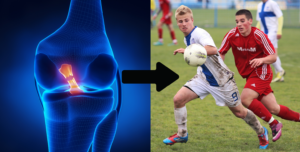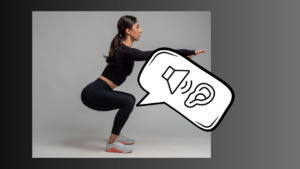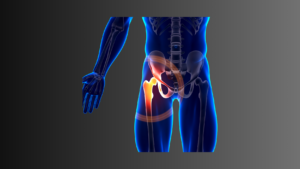
Vorderer Knieschmerz: Ursachen, Diagnose und Behandlungsmöglichkeiten

Einleitung
Vorderer Knieschmerz kann sich durch Belastungen wie Treppensteigen, Kniebeugen oder langes Sitzen bemerkbar machen und tritt häufig bei aktiven Menschen auf. Zu den bekanntesten Krankheitsbildern gehören das Patellofemorale Schmerzsyndrom (PFS) und das Patellaspitzensyndrom, auch als Patellasehnentendinopathie (PT) oder „Jumpers Knee“ bekannt.
Was sind Patellofemorales Schmerzsyndrom und Patellasehnentendinopathie?
Das Patellofemorale Schmerzsyndrom (PFS) beschreibt Schmerzen an der Vorderseite des Knies, die oft durch eine Fehlbelastung im patellofemoralen Gelenk verursacht werden. Es betrifft häufig junge Sportler, insbesondere Frauen, und ist eine der häufigsten Ursachen für sportmedizinische Konsultationen. Eine schwache Quadrizeps- und Gesäßmuskulatur kann ebenfalls zu PFS beitragen.
Das Patellaspitzensyndrom oder Patellasehnentendinopathie (PT) betrifft die Patellasehne und tritt meist bei Sportarten mit Sprungbelastungen auf. Diese Sehnenverletzung verursacht belastungsbedingte Schmerzen, oft an der Spitze der Kniescheibe. Männer sind etwas häufiger betroffen, besonders bei Sportarten wie Volleyball oder Basketball.
Diagnose und Risikofaktoren
Die Diagnose erfolgt durch die klinische Untersuchung und eine Schmerzlokalisation. MRTs können zur Abgrenzung von Differenzialdiagnosen hilfreich sein. Patienten mit PFS und PT berichten oft von Schmerzen während oder nach Phasen erhöhter Aktivität. Risikofaktoren für PFS sind unter anderem ein hoher Body-Mass-Index (BMI), eine übermäßige Trainingsbelastung oder unzureichende Muskulatur. Für PT spielen repetitive Sprungbewegungen eine Rolle.
Behandlungsmöglichkeiten
Die Behandlung beider Erkrankungen beginnt in der Regel konservativ mit Belastungsmanagement und Physiotherapie. Beim PFS ist es wichtig, die Belastung zu reduzieren und schmerzprovozierende Aktivitäten zu vermeiden. Kraftübungen für Knie und Hüfte sind langfristig hilfreich. Chirurgische Eingriffe sind selten und nur als letzter Ausweg empfohlen.
Für die Patellasehnentendinopathie ist ein progressives Training entscheidend, das Sehnenbelastung und -rehabilitation berücksichtigt. Exzentrisches Training hat sich als wirksam erwiesen, obwohl es anfangs Schmerzen provozieren kann. Injektionstherapien wie Cortison oder PRP bieten kurzfristige Linderung, zeigen aber langfristig weniger Erfolg als regelmäßiges Training.
Beispielübungen für PFS
Eine Kombination aus Knie- und Hüftübungen, wie Wall Sits, Glute Bridges und Step-ups, hilft, die Kraft und Beweglichkeit zu verbessern. Diese Übungen sollten schrittweise gesteigert und individuell angepasst werden, um die Beschwerden zu lindern.
Vier Stufen der Sehnenrehabilitation
Die Rehabilitation bei PT folgt vier Stufen: Isometrie, dynamisches Krafttraining, explosive Übungen und sportartspezifisches Training. Diese Stufen ermöglichen eine systematische Steigerung der Belastbarkeit der Sehne und sind wichtig für eine langfristige Heilung.
Fazit
Vorderer Knieschmerz ist eine häufige Problematik bei Sportlern und aktiven Menschen. Sowohl das Patellofemorale Schmerzsyndrom als auch die Patellasehnentendinopathie können durch konservative Maßnahmen gut behandelt werden. Entscheidend ist ein angepasstes Belastungsmanagement und ein individueller Trainingsplan. Geduld ist erforderlich, da die Heilung, insbesondere bei PT, mehrere Monate dauern kann.
Dein DK Sports & Physio Team aus der Karlsruher Oststadt
Den ausführlichen Artikel findest du in unserer DK Academy.
Wir geben Physiotherapeuten, Trainern und allen Wissbegierigen einen sachlichen Einblick in die Physiotherapie und helfen so die Rehabilitation und das Training nach Verletzungen oder Beschwerden effizienter zu gestalten.
Sichere dir vollen Zugriff auf unsere Rehab Live Sessions, exklusive Review- und Blogartikel, Simple Tipps und Infografiken.

Du benötigst Physiotherapie im Raum Karlsruhe? Dann sind wir gerne für dich da und unterstützen dich!
Dein DK Sports & Physio Team aus der Karlsruher Oststadt
Unsere weiteren Blog-Artikel


Was manuelle Lymphdrainage (nicht) kann

Gelenkgeräusche – muss man sich Gedanken machen?

Seitlicher Hüftschmerz Update und Deep-Dive

Faszinierend oder fast nicht belegt – Der Faszien-Hype kritisch betrachtet

Von Eisbädern bis Foam Rolling: Was hilft wirklich gegen Muskelkater?

Kreuzbandrehabilitation – Wie lange brauche ich die Unterarmgehstützen?

Wie schief bin ich eigentlich und ist das schlimm?
Quellenangaben:
[1] E. Witvrouw, R. Lysens, J. Bellemans, D. Cambier, und G. Vanderstraeten, „Intrinsic risk factors for the development of anterior knee pain in an athletic population. A two-year prospective study“, Am. J. Sports Med., Bd. 28, Nr. 4, S. 480–489, Aug. 2000.
[2] M. Boling, D. Padua, S. Marshall, K. Guskiewicz, S. Pyne, und A. Beutler, „Gender differences in the incidence and prevalence of patellofemoral pain syndrome: Epidemiology of patellofemoral pain“, Scand. J. Med. Sci. Sports, Bd. 20, Nr. 5, S. 725–730, Okt. 2010, doi: 10.1111/j.1600-0838.2009.00996.x.
[3] K. M. Crossley, M. J. Callaghan, und R. van Linschoten, „Patellofemoral pain“, BMJ, S. h3939, Nov. 2015, doi: 10.1136/bmj.h3939.
[4] N. E. Lankhorst, S. M. A. Bierma-Zeinstra, und M. van Middelkoop, „Factors associated with patellofemoral pain syndrome: a systematic review“, Br. J. Sports Med., Bd. 47, Nr. 4, S. 193–206, März 2013, doi: 10.1136/bjsports-2011-090369.
[5] M. S. Rathleff, C. R. Rathleff, K. M. Crossley, und C. J. Barton, „Is hip strength a risk factor for patellofemoral pain? A systematic review and meta-analysis“, Br. J. Sports Med., Bd. 48, Nr. 14, S. 1088–1088, Juli 2014, doi: 10.1136/bjsports-2013-093305.
[6] R. W. Willy und E. P. Meira, „CURRENT CONCEPTS IN BIOMECHANICAL INTERVENTIONS FOR PATELLOFEMORAL PAIN“, Int. J. Sports Phys. Ther., Bd. 11, Nr. 6, S. 877–890, Dez. 2016.
[7] A. Scott u. a., „ICON 2019: International Scientific Tendinopathy Symposium Consensus: Clinical Terminology“, Br. J. Sports Med., Bd. 54, Nr. 5, S. 260–262, März 2020, doi: 10.1136/bjsports-2019-100885.
[8] S. Morgan und F. F. Coetzee, „Proposing a Patellar Tendinopathy Screening tool following a systematic review“, South Afr. J. Physiother., Bd. 74, Nr. 1, Sep. 2018, doi: 10.4102/sajp.v74i1.454.
[9] S. Tom, J. Parkinson, M. Z. Ilic, J. Cook, J. A. Feller, und C. J. Handley, „Changes in the composition of the extracellular matrix in patellar tendinopathy“, Matrix Biol., Bd. 28, Nr. 4, S. 230–236, Mai 2009, doi: 10.1016/j.matbio.2009.04.001.
[10] K. M. Khan, „Time to abandon the ‚tendinitis‘ myth“, BMJ, Bd. 324, Nr. 7338, S. 626–627, März 2002, doi: 10.1136/bmj.324.7338.626.
[11] B. J. F. Dean, P. Gettings, S. G. Dakin, und A. J. Carr, „Are inflammatory cells increased in painful human tendinopathy? A systematic review“, Br. J. Sports Med., Bd. 50, Nr. 4, S. 216–220, Feb. 2016, doi: 10.1136/bjsports-2015-094754.
[12] S. G. Dakin u. a., „Chronic inflammation is a feature of Achilles tendinopathy and rupture“, Br. J. Sports Med., Bd. 52, Nr. 6, S. 359–367, März 2018, doi: 10.1136/bjsports-2017-098161.
[13] G. Jomaa u. a., „A systematic review of inflammatory cells and markers in human tendinopathy“, BMC Musculoskelet. Disord., Bd. 21, Nr. 1, S. 78, Dez. 2020, doi: 10.1186/s12891-020-3094-y.
[14] Ø. B. Lian, L. Engebretsen, und R. Bahr, „Prevalence of Jumper’s Knee among Elite Athletes from Different Sports: A Cross-sectional Study“, Am. J. Sports Med., Bd. 33, Nr. 4, S. 561–567, Apr. 2005, doi: 10.1177/0363546504270454.
[15] K. E. DeHaven und D. M. Lintner, „Athletic injuries: Comparison by age, sport, and gender“, Am. J. Sports Med., Bd. 14, Nr. 3, S. 218–224, Mai 1986, doi: 10.1177/036354658601400307.
[16] J. E. Taunton, M. B. Ryan, D. B. Clement, D. C. McKenzie, D. R. Lloyd-Smith, und B. D. Zumbo, „A retrospective case-control analysis of 2002 running injuries“, Br. J. Sports Med., Bd. 36, Nr. 2, S. 95–101, Apr. 2002, doi: 10.1136/bjsm.36.2.95.
[17] A. Tállay u. a., „[Prevalence of patellofemoral pain syndrome. Evaluation of the role of biomechanical malalignments and the role of sport activity]“, Orv. Hetil., Bd. 145, Nr. 41, S. 2093–2101, Okt. 2004.
[18] H. Van Der Worp, M. Van Ark, S. Roerink, G.-J. Pepping, I. Van Den Akker-Scheek, und J. Zwerver, „Risk factors for patellar tendinopathy: a systematic review of the literature“, Br. J. Sports Med., Bd. 45, Nr. 5, S. 446–452, Apr. 2011, doi: 10.1136/bjsm.2011.084079.
[19] J. Zwerver, S. W. Bredeweg, und I. van den Akker-Scheek, „Prevalence of Jumper’s Knee Among Nonelite Athletes From Different Sports: A Cross-Sectional Survey“, Am. J. Sports Med., Bd. 39, Nr. 9, S. 1984–1988, Sep. 2011, doi: 10.1177/0363546511413370.
[20] A. J. De Vries u. a., „The impact of patellar tendinopathy on sports and work performance in active athletes“, Res. Sports Med., Bd. 25, Nr. 3, S. 253–265, Juli 2017, doi: 10.1080/15438627.2017.1314292.
[21] American Academy of Family Physicians, „Information from your family doctor. Patellofemoral pain syndrome“, Am. Fam. Physician, Bd. 75, Nr. 2, S. 204, Jan. 2007.
[22] T. M. Coupal, P. L. Munk, H. A. Ouellette, H. Al-Shikarchy, P. I. Mallinson, und H. Choudur, „Popping the cap: the constellation of MRI findings in patellofemoral syndrome“, Br. J. Radiol., S. 20170770, Apr. 2018, doi: 10.1259/bjr.20170770.
[23] S. F. Dye, „The pathophysiology of patellofemoral pain: a tissue homeostasis perspective“, Clin. Orthop., Nr. 436, S. 100–110, Juli 2005.
[24] R. A. Van Der Heijden, N. E. Lankhorst, R. Van Linschoten, S. M. Bierma-Zeinstra, und M. Van Middelkoop, „Exercise for treating patellofemoral pain syndrome“, Cochrane Database Syst. Rev., Bd. 2015, Nr. 1, Jan. 2015, doi: 10.1002/14651858.CD010387.pub2.
[25] C. A. Logan u. a., „Systematic Review of the Effect of Taping Techniques on Patellofemoral Pain Syndrome“, Sports Health Multidiscip. Approach, Bd. 9, Nr. 5, S. 456–461, Sep. 2017, doi: 10.1177/1941738117710938.
[26] P. Kannus, A. Natri, T. Paakkala, und M. Järvinen, „An Outcome Study of Chronic Patellofemoral Pain Syndrome. Seven-Year Follow-up of Patients in a Randomized, Controlled Trial*“:, J. Bone Jt. Surg., Bd. 81, Nr. 3, S. 355–63, März 1999, doi: 10.2106/00004623-199903000-00007.
[27] B. J. Eckenrode, D. M. Kietrys, A. Brown, J. S. Parrott, und B. Noehren, „Effects of high frequency strengthening on pain sensitivity and function in female runners with chronic patellofemoral pain“, Phys. Ther. Sport, Bd. 67, S. 31–40, Mai 2024, doi: 10.1016/j.ptsp.2024.02.007.
[28] E. Rio u. a., „Tendon neuroplastic training: changing the way we think about tendon rehabilitation: a narrative review“, Br. J. Sports Med., Bd. 50, Nr. 4, S. 209–215, Feb. 2016, doi: 10.1136/bjsports-2015-095215.
[29] J. Näslund, U.-B. Näslund, S. Odenbring, und T. Lundeberg, „Comparison of symptoms and clinical findings in subgroups of individuals with patellofemoral pain“, Physiother. Theory Pract., Bd. 22, Nr. 3, S. 105–118, Jan. 2006, doi: 10.1080/09593980600724246.
[30] S. R. Piva u. a., „Associates of Physical Function and Pain in Patients with Patellofemoral Pain Syndrome“, Arch. Phys. Med. Rehabil., Bd. 90, Nr. 2, S. 285–295, Feb. 2009, doi: 10.1016/j.apmr.2008.08.214.
[31] N. J. Collins, L. M. Bisset, K. M. Crossley, und B. Vicenzino, „Efficacy of nonsurgical interventions for anterior knee pain: systematic review and meta-analysis of randomized trials“, Sports Med. Auckl. NZ, Bd. 42, Nr. 1, S. 31–49, Jan. 2012, doi: 10.2165/11594460-000000000-00000.
[32] G. L. Moseley, „Teaching People About Pain: Why do we Keep Beating Around the Bush?“, Pain Manag., Bd. 2, Nr. 1, S. 1–3, Jan. 2012, doi: 10.2217/pmt.11.73.
[33] M. Kongsgaard u. a., „Region specific patellar tendon hypertrophy in humans following resistance training“, Acta Physiol., Bd. 191, Nr. 2, S. 111–121, Okt. 2007, doi: 10.1111/j.1748-1716.2007.01714.x.
[34] A. Scott u. a., „Platelet-Rich Plasma for Patellar Tendinopathy: A Randomized Controlled Trial of Leukocyte-Rich PRP or Leukocyte-Poor PRP Versus Saline“, Am. J. Sports Med., Bd. 47, Nr. 7, S. 1654–1661, Juni 2019, doi: 10.1177/0363546519837954.
[35] G. Rodas u. a., „Effect of Autologous Expanded Bone Marrow Mesenchymal Stem Cells or Leukocyte-Poor Platelet-Rich Plasma in Chronic Patellar Tendinopathy (With Gap >3 mm): Preliminary Outcomes After 6 Months of a Double-Blind, Randomized, Prospective Study“, Am. J. Sports Med., Bd. 49, Nr. 6, S. 1492–1504, Mai 2021, doi: 10.1177/0363546521998725.
[36] J. L. Dragoo, A. S. Wasterlain, H. J. Braun, und K. T. Nead, „Platelet-Rich Plasma as a Treatment for Patellar Tendinopathy: A Double-Blind, Randomized Controlled Trial“, Am. J. Sports Med., Bd. 42, Nr. 3, S. 610–618, März 2014, doi: 10.1177/0363546513518416.
[37] J. S. Everhart u. a., „Treatment Options for Patellar Tendinopathy: A Systematic Review“, Arthrosc. J. Arthrosc. Relat. Surg., Bd. 33, Nr. 4, S. 861–872, Apr. 2017, doi: 10.1016/j.arthro.2016.11.007.
[38] H. Visnes, A. Hoksrud, J. Cook, und R. Bahr, „No Effect of Eccentric Training on Jumper??s Knee in Volleyball Players During the Competitive Season: A Randomized Clinical Trial“, Clin. J. Sport Med., Bd. 15, Nr. 4, S. 227–234, Juli 2005, doi: 10.1097/01.jsm.0000168073.82121.20.
[39] P. Malliaras, J. Cook, C. Purdam, und E. Rio, „Patellar Tendinopathy: Clinical Diagnosis, Load Management, and Advice for Challenging Case Presentations“, J. Orthop. Sports Phys. Ther., Bd. 45, Nr. 11, S. 887–898, Nov. 2015, doi: 10.2519/jospt.2015.5987.
[40] S. J. Breda u. a., „Effectiveness of progressive tendon-loading exercise therapy in patients with patellar tendinopathy: a randomised clinical trial“, Br. J. Sports Med., Bd. 55, Nr. 9, S. 501–509, Mai 2021, doi: 10.1136/bjsports-2020-103403.
[41] C. A. Macera, „Lower Extremity Injuries in Runners: Advances in Prediction“, Sports Med., Bd. 13, Nr. 1, S. 50–57, Jan. 1992, doi: 10.2165/00007256-199213010-00005.
[42] J. Fairbank, P. Pynsent, J. Van Poortvliet, und H. Phillips, „Mechanical factors in the incidence of knee pain in adolescents and young adults“, J. Bone Joint Surg. Br., Bd. 66-B, Nr. 5, S. 685–693, Nov. 1984, doi: 10.1302/0301-620X.66B5.6501361.
[43] H. F. Hart u. a., „May the force be with you: understanding how patellofemoral joint reaction force compares across different activities and physical interventions—a systematic review and meta-analysis“, Br. J. Sports Med., Bd. 56, Nr. 9, S. 521–530, Mai 2022, doi: 10.1136/bjsports-2021-104686.
[44] H. F. Hart, C. J. Barton, K. M. Khan, H. Riel, und K. M. Crossley, „Is body mass index associated with patellofemoral pain and patellofemoral osteoarthritis? A systematic review and meta-regression and analysis“, Br. J. Sports Med., Bd. 51, Nr. 10, S. 781–790, Mai 2017, doi: 10.1136/bjsports-2016-096768.
[45] M. A. Bahr und R. Bahr, „Jump frequency may contribute to risk of jumper’s knee: a study of interindividual and sex differences in a total of 11 943 jumps video recorded during training and matches in young elite volleyball players“, Br. J. Sports Med., Bd. 48, Nr. 17, S. 1322–1326, Sep. 2014, doi: 10.1136/bjsports-2014-093593.